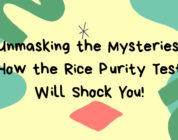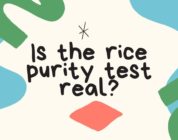Your one-stop guide to the intriguing and enlightening world of the official rice purity test.
Howdy folks! Have you ever heard about the official rice purity test? If you’ve been around the block of internet culture, chances are you have! But for the uninitiated, let me pull back the curtain on this intriguing piece of web folklore. This guide will help you understand the ins, outs, and the in-betweens of the official rice purity test, all while maintaining a fun, conversational tone. So, buckle up and get ready for an exciting journey!
Part 1: What is The Official Rice Purity Test?
A. The Genesis of the Test
The tale of the official rice purity test begins at Rice University, a top-tier institution known for its emphasis on community and student life. So, you might ask, what’s the link between a prestigious university and a purity test? Well, it’s a tradition that harks back to the university’s orientation week, a whirlwind of activities designed to welcome new students into the fold.
The test was designed as a checklist of “experiences,” divided into different categories like crime, drugs, sex, deceit, and others. The aim? To serve as an ice breaker to help new students form connections and start conversations. And boy, did it work! The test quickly became an integral part of Rice’s unique student culture.
B. Understanding the Format
At its core, the official rice purity test is a 100-item questionnaire. Each question is phrased as a statement, and if you’ve experienced the situation described, you check it off. Simple, right? The final score is the total of unchecked items, ranging from 0 to 100. The higher the score, the “purer” you are deemed to be.
C. The Online Evolution
As the Internet began to permeate every facet of our lives, the test made its way online. It became a viral sensation, with people all over the world keen on trying it out. Today, it’s seen as a fun, if slightly cheeky, way of introspection, and a tool to spark conversations about diverse experiences.
Part 2: Interpreting The Official Rice Purity Test
A. The Purpose
While the official rice purity test started as a conversation starter among freshmen, its purpose has since evolved. Nowadays, it’s seen as a fun activity to explore one’s experiences and share results with friends. It’s not meant to judge or shame individuals for their life choices or lack thereof. So, it’s important to remember – your score doesn’t define you!
B. The Score
The interpretation of the test score is quite simple – a higher score indicates fewer experiences checked off in the questionnaire, implying a higher ‘purity’. However, it’s not a moral compass. The test is designed to reflect the spectrum of human experiences and not to serve as a judgment of character or morality.
Part 3: Critiques and Controversies Surrounding The Official Rice Purity Test
A. Critiques of the Test
As you can imagine, not everyone’s a fan of the official rice purity test. Critics argue that it oversimplifies complex life experiences and can create a harmful comparison culture. They also point out that the test seems to equate ‘purity’ with inexperience or innocence, which is an outdated and simplistic viewpoint.
B. Controversies and Resolutions
Despite the criticisms, the test’s popularity continues. Over time, revisions have been made to make it more inclusive and less judgmental. The focus has shifted more towards fostering open conversations and promoting understanding about different experiences.
Part 4: The Popularity of The Official Rice Purity Test in Popular Culture
A. The Test in Digital Culture
From being a university tradition, the official rice purity test has now entered popular digital culture. It’s common to see social media influencers and celebrities taking the test and sharing their results with their audience, sparking discussions and debates.
B. The Test as a Communication Tool
The official rice purity test has also found a place in education and awareness campaigns. For example, some sex education programs use it as a conversation starter to discuss important topics around consent, safety, and boundaries.
Conclusion
The official rice purity test is more than just an online questionnaire. It’s a cultural phenomenon, a conversation starter, a self-introspection tool, and a viral digital trend. Its journey from a college orientation program to a global internet sensation is a testament to its engaging, universal appeal. So, whether you score high or low, remember – it’s all in good fun. After all, life’s about making memories, not scoring points!
FAQs
- What is the official rice purity test? The official rice purity test is a 100-question self-graded survey that assesses the participant’s supposed degree of innocence in worldly matters, divided into different categories such as crime, sex, and drugs.
- How does the scoring work in the official rice purity test? The score ranges from 0 to 100, with 100 being the most ‘pure’. The score is calculated by counting the number of statements not checked by the participant.
- Who created the official rice purity test? The official rice purity test was created by students at Rice University as a part of their college orientation program.
- What is the purpose of the official rice purity test? Initially, it was designed as a bonding experience for college freshmen. Now, it serves as a fun online activity and a conversation starter on various topics.
- Is the official rice purity test a reliable indicator of one’s character? No, it’s not a moral or character judgment tool. It’s a simple checklist of diverse experiences and is meant to spark conversations and self-reflection.
- Is the official rice purity test controversial? It has been critiqued for oversimplifying life experiences and creating a comparison culture. However, revisions have been made over time to address these concerns.




